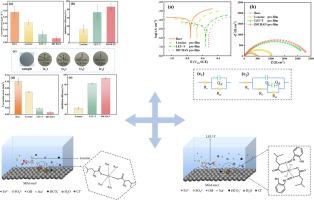亮氨酸席夫碱衍生物的制备及其对低碳钢大气腐蚀的抑制作用
IF 6.3
3区 工程技术
Q1 ENGINEERING, CHEMICAL
Journal of the Taiwan Institute of Chemical Engineers
Pub Date : 2025-09-27
DOI:10.1016/j.jtice.2025.106429
引用次数: 0
摘要
希夫碱是一种环保的金属腐蚀缓蚀剂。本研究以亮氨酸和水杨醛为原料合成了一种新型的基于希夫碱的挥发性缓蚀剂(VCI)。本研究评估了低浓铀- t对低碳钢的挥发性缓蚀性能,并在模拟大气腐蚀溶液中检验了其防腐效果。方法采用傅里叶变换红外(FT-IR)吸收光谱对缓蚀剂进行表征。通过挥发性缓蚀能力(VIA)测试、电化学测量(包括动电位极化(PDP)和电化学阻抗谱(EIS))和理论计算,评估了缓蚀剂对低碳钢的腐蚀行为、缓蚀效率和防腐机理。扫描电子显微镜(SEM)和原子力显微镜(AFM)证实了在低碳钢上形成的抑制膜。结果表明,在VIA实验中,LEU-T的抑菌率为82.18%。电化学测量表明,在钢基体上形成的抑制膜导致电荷转移电阻的增加。电化学阻抗谱分析表明,亮氨酸和LEU-T的缓蚀效率分别为67.84%和83.90%。SEM和AFM观察表明,缓蚀剂形成了一个保护性的VCI涂层,有效地延缓了钢的腐蚀。LEU-T在低碳钢上的吸附能(-136.13 kJ/mol)大于亮氨酸(-88.48 kJ/mol)。本文章由计算机程序翻译,如有差异,请以英文原文为准。

Preparation of Schiff base derivates from leucine and its inhibition effect on the atmospheric corrosion of mild steel
Background
Schiff bases are attractive as eco-friendly corrosion inhibitors for the protection of metals. In this study, a novel volatile corrosion inhibitor (VCI) based on Schiff base (LEU-T) is synthesized from leucine and salicylaldehyde. This study evaluates the volatile corrosion inhibition performance of LEU-T on mild steel and examines its anti-corrosion effect in a simulated atmospheric corrosion solution.
Methods
The corrosion inhibitor is characterized by Fourier transform infrared (FT-IR) absorption spectra. The corrosion behavior, inhibition efficiency, and anti-corrosion mechanism of the inhibitor on mild steel are evaluated using volatile inhibition ability (VIA) tests, electrochemical measurements (including potentiodynamic polarization (PDP) and electrochemical impedance spectroscopy (EIS)), and theoretical calculations. Scanning electron microscopy (SEM) and atomic force microscope (AFM) confirm the formation of the inhibitive films on mild steel.
Significant Findings
The results demonstrate that LEU-T exhibits outstanding inhibition efficiency of 82.18 % in VIA tests. Electrochemical measurements indicate that the formed inhibitive films on the steel substrate lead to an increase in the charge transfer resistance. The corrosion inhibition efficiencies of leucine and LEU-T, as determined by electrochemical impedance spectroscopy, are 67.84 % and 83.90 %, respectively. SEM and AFM observations indicate that the inhibitor forms a protective VCI coating, effectively retarding the steel corrosion. The LEU-T has larger adsorption energy (-136.13 kJ/mol) compared to leucine (-88.48 kJ/mol) on mild steel.
求助全文
通过发布文献求助,成功后即可免费获取论文全文。
去求助
来源期刊
CiteScore
9.10
自引率
14.00%
发文量
362
审稿时长
35 days
期刊介绍:
Journal of the Taiwan Institute of Chemical Engineers (formerly known as Journal of the Chinese Institute of Chemical Engineers) publishes original works, from fundamental principles to practical applications, in the broad field of chemical engineering with special focus on three aspects: Chemical and Biomolecular Science and Technology, Energy and Environmental Science and Technology, and Materials Science and Technology. Authors should choose for their manuscript an appropriate aspect section and a few related classifications when submitting to the journal online.

 求助内容:
求助内容: 应助结果提醒方式:
应助结果提醒方式:


